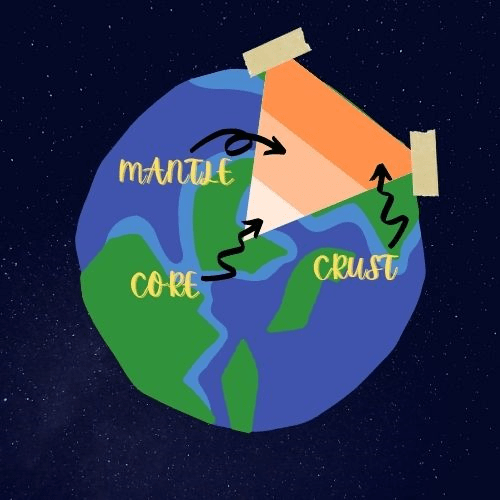Life on the Pale Blue Dot

“Grandpa’s” song (Bharat Ek Khoj title song):
सृष्टी से पहले सत् नहीं था, असत् भी नहीं
अन्तरिक्ष भी नहीं, आकाश भी नहीं था
छिपा था क्या? कहाँ? किसने ढका था?
उस पल तो, अगम अतल जल भी कहाँ था?
This beautiful shloka is the translation of the Nasadiya Sukta, a hymn from the Rig Veda
Up until this point, we have discussed as to how the Universe as we know it, came into existence. As you can see, the brilliant minds of our ancient civilization, somehow were able to decipher the secrets of the Universe way before any of our grandfather’s-grandfather’s-grandfather’s-grandfather’s grandfather arrived on this planet! A very interesting line from the aforementioned shloka speaks of the nonexistence of the “cosmic waters”, which pervaded the Universe after the Big Bang. Taking a cue from this amazing hymn, we’ll be talking about ‘waters’, but in a different context! So far, we’ve only seen the chaos that ensued after this Universe formed. But some billion years ago, in a far-off planet of a far-off galaxy, the order was forming from this chaos. All of us have surely wondered about the story behind one of the greatest phenomenon we’ve ever witnessed. Yes, it is the emergence of life we are talking about, on the very planet which we now call home: Earth.
So, how was this the big ball of possibilities that has provided for us since time immemorable, created in the first place? Before we plunge into the deep waters to start looking for life, let us talk a little about how our planet came into existence and proved to be exactingly conducive for life to even perpetuate!
Well, we have talked about the formation of planets in the previous issue, and just like any other planet, Earth is also a product of gas and dust. But, we can agree that the universe surely hired an extra pair of forces to make it hot to trot with a few magical touches. If you remember, we also covered the formation of the Moon. So, let’s continue our quest to find out more about what lies above and beyond.
It’s always better to have a stronger core!

Earth is like an onion. There is more to the Earth than we can see. We are blessed to have no dearth of brilliant minds all around us who have taken us above the big skies and into space. But even they could not venture into the inner recesses of our planet. That part is strictly off-limits for us!
Seismology has helped us lock the ultra-level to this issue. We can visit the core of the Earth just by sitting in a lab with a few rocks to keep us company. Right from the properties and composition to the characteristics of the Earth, now we can study it all. The Earth is divided into three main parts – the crust, the mantle, and the core. Well, the mantle is further divided into the upper and lower mantle, while the core is subdivided into the outer and inner core.
The crust is the outermost part of the planet and is hard in nature, while the depth of the crust ranges from 5-70 km. This layer just forms 1% of the entire volume of the earth! The crust forms the lithosphere with the uppermost layer of the mantle. The lithosphere is an irregular layer of rocks and is very thick.
The mantle makes 84% of the Earth’s volume and is predominantly solid. The upper mantle starts at the ‘Mohorovocic’s Discontinuity’, and extends from a depth of 7-35 km downwards to a depth of 410 km. The mantle is chemically different from the crust. The lower mantle lies between 660-2891 km in depth. It is speculated to be seismologically homogenous.
The outer core, 2300 km thick part, is confirmed to be completely liquid. The temperature is super high in the outer core thus the fluid is found to be in a low-viscosity state. The solid inner core is hypothesized to have a lot of heavy elements. It is a pretty hot part of the Earth as well and is estimated to be about 5700 K.
We are lucky to live on such a strong land!
Gaia was in her element.

After the Moon formed as a result of a collision between the Earth and a Mars-sized body, Earth was still pretty hot and volcanically active. This primitive atmosphere took some time to cool down. As it slowly cooled down, the lighter elements started to react with each other. The early atmosphere was rich in hydrogen, carbon, nitrogen, and sulphur. Hydrogen being more active, reacted with other elements to form chemicals like methane, water, ammonia, and hydrogen sulphide.
The atmosphere lacked an ozone layer back then. Thus, under the influence of high energy phenomena such as lightning strikes, the early molecules in the oceans got a chance to undergo reactions such as oxidation, reduction, condensation, and polymerization. The products of these reactions were simple molecules like amino acids, monosaccharides, purines, pyrimidines, fatty acids, etc. These molecules upped their game by getting polymerized again to form polysaccharides, proteins, fats, nucleosides, and nucleotides. These would later come to be known as the building blocks of life.
And then there was water!
Eventually, the temperature decreased to a point where steam condensed into water and resulted in heavy rainfall. Earth became cooler although volcanic activity still continued. Even under the impact of newly forming oceans, super-volcanoes did not give up their routine! Lava continuously flowed on the Earth’s surface for nearly 700 million years thereafter.
Water comes in all flows and volumes. It is there in the water puddle you just stepped into (in a previous life now, sigh). It is there in your sneeze (let’s vote to make this the Most Hated Word Of The Year, shall we?). Most importantly, it is in you, and you were in it, about 3 to 4 billion years ago. But back then, you were not yourself! Before this gets too deep, let’s swim over to the shallower end of things (too many water-related references). Water continued to form in the atmosphere, and be delivered to the Earth via rainfall. About 4.4 billion years ago, the oceans which had formed, covered more than 80% of Earth’s surface area!
A very curious development occurred after that. As we stated earlier, we’ll be drawing parallels between the “cosmic waters” which pervaded our Universe after the Big Bang, and ‘normal’ water. Well, after this curious event, the waters which pervaded our planet witnessed an “explosion” very similar to the Big Bang. This event was the formation of the first self-replicating complex molecule.
Now, it is not yet clear how exactly this molecule came about. There are of course a lot of theories, but no solid evidence to back them. We saw earlier that simple molecules combined in the oceans to form complex and even more complex molecules. One of these molecules beat everyone to it and formed a mechanism through which it could perpetuate on its own. The most accepted theory states that this molecule was RNA. RNA stands for Ribo Nucleic Acid. It is the progenitor of DNA, Deoxyribo Nucleic Acid. DNA in today’s language is used to convey the crux of things, of how something is or was at its very primitive level. Remember though, that DNA itself is a language, and this language governed the expansion of life. But, where does RNA fit in here? It is a classic ” who came first, the chicken or the egg” paradox!
The RNA theory states that it was indeed RNA which evolved first. But due to its unstable nature, it was not able to carry the information required per se, to pass on to its ‘children’. And so, DNA, a more stable molecule, was delegated the task of information parcelling. Now, a valid question at this point would be: Why is DNA more stable than RNA? Well, to answer that, imagine running with 10 bags on your head. Now, offload 2. Ok, 3. Makes it easier, doesn’t it? Something similar can be said for RNA and DNA as well.
Omnis cellula-e-cellula
The origin of life on our planet has been the second-most heatedly debated topic in scientific circles, the first being the origin of this Universe itself! Like the various theories that proposed divine intervention in the formation of the Universe, the origin of life too had ‘divine’ theories to support them. One of those theories, called Creationism, was one of the first theories which spoke about the formation of life on our planet. Its evidence was first found in the Old Testament of the Bible, and since then, this theory has evolved into various branches and sub-branches (pun intended). It said that all life forms were brought into existence by God Himself, on six continuous days, until He created the first Man and Woman (namely, Adam and Eve), in the Garden of Eden. It puts the age of the Earth to be around 4000 years old only and says that all living forms which exist today were created just the way they are on Creation day. It was still a widely accepted theory until one fine day, a young man named Charles Darwin decided to undertake a voyage around the world aboard the H.M.S Beagle.

Upon reaching the Galapagos Islands, Darwin found nearly 14 different species of finches, now famously called Darwin’s finches. He noticed that these passerine birds were very similar morphologically, except their beaks, which were all differently designed according to the species’ particular diet and eating patterns. Darwin then inferred that all of these species originated from a single South American relative, Tiaris obscurus, which must have migrated to the islands and whose progeny would have rapidly proliferated and adapted themselves according to their particular external environment. This and many other such observations led him to formulate and publish a book in 1859 which would start a heated and controversial discourse amongst the common folk, which continues up to this day: The Origin of Species. This book spoke about the concept of evolution, where every living organism evolved from a more primitive organism, and how the progeny of the ‘fittest’ individuals survived. We’ll delve deep into this topic in our next issue.

Hindu mythology spoke of evolution and ‘gradual enlightenment’ in a very interesting way. For the uninitiated, Hindu mythology is a small sect of philosophy based on various literary and scriptural stories and parables, which were originally passed down from generation to generation through oral word-of-mouth. However, upon closely studying one of these scriptures, namely Bhagavatam, we find a story called Dashavataram, which speaks about the ten forms the Hindu god Vishnu takes from time to time, to curb the evil in this world. What is to be noted, is that these ten forms are gradual upgradations from the previous ones, and they all form a hierarchy which resembles how Darwin described evolution thousands, if not tens of thousands of years later! Psych!


Authors:

Luminaa Anandh
Co-Founder at The Science Paradox

Urja Kuber
Co-Founder at The Science Paradox
Illustrator:

Anushree Krishnamurthy
Co-Founder at The Science Paradox
